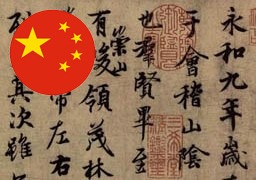In the era of digital communication, the ancient art of Chinese calligraphy holds an energetic reminder of the beauty and significance of traditional writing. Chinese calligraphy is more than just beautiful writing. Chinese calligraphy stands out as one of China’s most significant art forms. This art form has an effective cultural and historical significance that developed with time. Interestingly, this remains an essential part of China’s cultural legacy.
Chinese calligraphy, known as “shūfǎ” (书法), is more than just writing; it is an art form that combines creativity, discipline, and spirituality. The practice started during the Shang Dynasty (1600–1046 BCE), where early characters were written on oracle bones used for future prediction. These writings mark the earliest form of Chinese writing and laid the foundation for the development of the language. Over the centuries, various styles emerged ,each showing the artistic development of the language. The five main styles, Seal Script (篆书), Clerical Script (隶书), Regular Script (楷书), Running Script (行书), and Cursive Script (草书) each have their own characteristics and historical significance.

To create beautiful calligraphy, artists depend on a set of traditional tools known as the “Four Treasures of the Study”: the brush (毛笔), ink (墨), paper (纸), and inkstone (砚). Each tool plays a crucial role in the calligraphy process. The brush typically made from animal hair,Ink is traditionally made from grinding ink sticks on an inkstone with water, resulting in a rich and deep color that increases the beauty of the characters. The choice of paper can significantly affect the final appearance of the work. The inkstone serves as a mixing surface for the ink, and the quality of the ink produced is important for achieving the desired results in calligraphy.
Firstly , the art of calligraphy is deeply connected with Chinese philosophy. Influences from Confucianism, Daoism, and Buddhism highlighted the importance of harmony, balance, and inner peace . The act of writing becomes a meditative practice, allowing artists to express their feelings and thoughts through ink and brush. In Confucian thought, the act of writing is not merely a technical skill but a reflection of one’s character and moral honesty. A well-perfomed calligraphy piece is seen as a display of the calligrapher’s inner self.
Secondly, calligraphy techniques require practice and patience. Calligraphers often start with basic strokes and gradually develop into more complex characters. Mastery involves understanding the balance of each stroke, the pressure applied to the brush, and the rhythm of movement. This dedication to practice reflects the broader cultural value placed on dedication and continuous improvement in Chinese society.
Moreover, museums play an important role in preserving the rich heritage of this art form, such as the National Museum of China in Beijing, which contains a vast collection of calligraphic works from different dynasties. The Shanghai Museum also presents an attractive collection of calligraphy, highlighting both ancient and modern pieces. Another important place is the Calligraphy Museum of China, which is dedicated only to the art of calligraphy, offering exhibitions, workshops, and educational programs to promote understanding and appreciation of this cultural treasure.
Additionally, Chinese calligraphy continues to influence globally. Workshops and exhibitions are held worldwide, allowing people from various backgrounds to engage with and learn about the difficulties of calligraphy. There has been a comeback of interest in traditional arts, including calligraphy, among younger generations. Educational institutions are including calligraphy in their syllabus, recognizing its value in promoting cultural heritage. Also, international interest in Chinese culture has led to increased appreciation for calligraphy. Outside of China, classes are being offered globally, allowing people from diverse backgrounds to explore this cultural art form.
In the end, Chinese calligraphy remains a vital representation of cultural identity and artistic creativity. Traditional Chinese calligraphy remains popular, modern Chinese calligraphers have also explored new forms and techniques, incorporating contemporary styles and even digital tools into their work. This blending of old and new has allowed Chinese calligraphy to remain relevant and vibrant in the modern world while still maintaining its deep connection to China’s rich cultural heritage.

Ms. Asima Shahadat is PRCCSF Fellow and Participant of FJHS-PRCCSF Fellowship Program 2024














